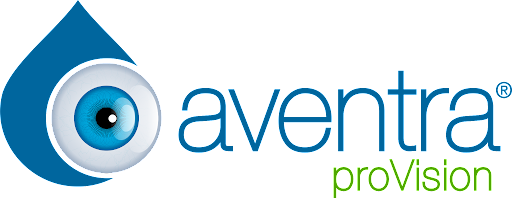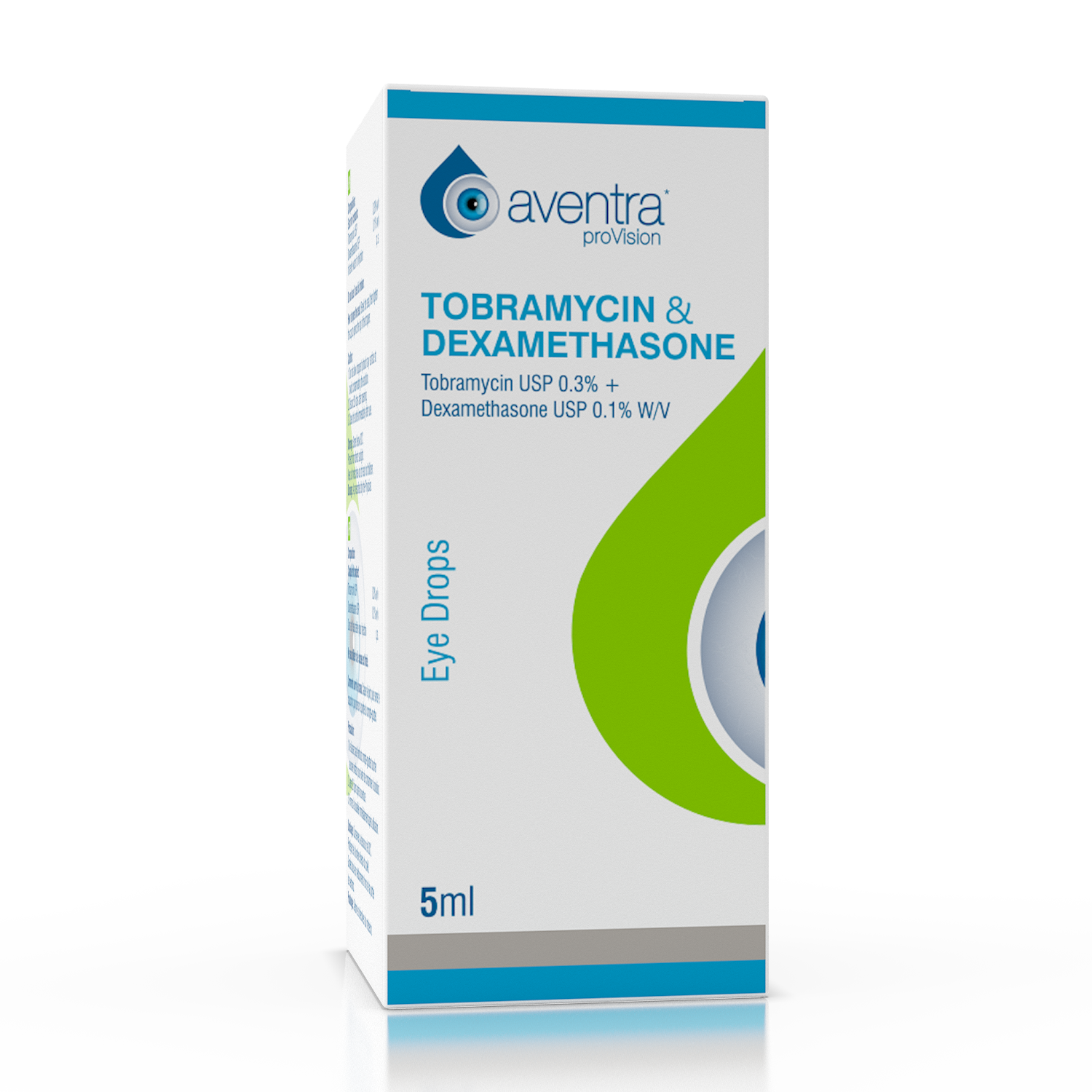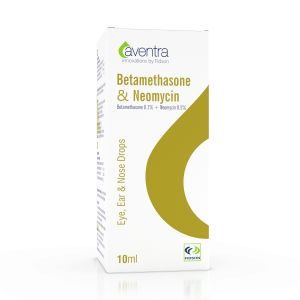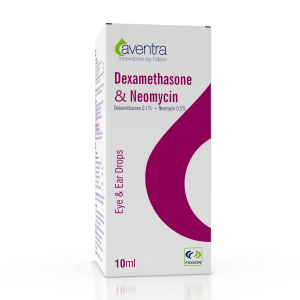Description
Read this leaflet carefully before you start taking this medicine. (PDF DOWNLOAD)
- Keep this leaflet. You may need to read it again before, during or after use of this medicine. • If you have any further questions, ask your health care provider.
- This medicine has been prescribed for you only. Do not pass it on to others. It may harm them, even if their symptoms are the same as yours.
- If any of the side effects become serious, or if you notice any side effects not listed in this leaflet, please inform your healthcare provider.
In this leaflet:
- What Tobramycin 0.3%+Dexamethasone 0.1% eyedrops is and what it is used for 2. What you need to know before you use Tobramycin 0.3%+Dexamethasone 0.1% eyedrops
- How to use Tobramycin 0.3%+Dexamethasone 0.1% eyedrops
- Possible side effects
- How to store Tobramycin 0.3%+Dexamethasone 0.1% eyedrops
- Contents of the pack and other information
- WHAT TOBRAMYCIN 0.3%+DEXAMETHASONE 0.1% EYEDROPS IS AND WHAT IT IS USED FOR
This contains dexamethasone a corticosteroid and tobramycin, an antibiotic which is active against a wide range of bacteria that may infect the eye. It is used to prevent and treat inflammation and prevent possible infection of the eye after cataract surgery in adults and children aged 2 years and older.
- WHAT YOU NEED TO KNOW BEFORE TAKING TOBRAMYCIN 0.3%+DEXAMETHASONE 0.1% EYEDROPS
Do not take Tobramycin 0.3%+Dexamethasone 0.1% eyedrops:
- If you have or think that you have any type of infection of the eye. Use of corticosteroids may make infections worse.
- If you have a sticky discharge from your eye.
- If you have a red eye that has not been seen by a doctor.
- If you are allergic to tobramycin or dexamethasone or to any of the other ingredients. If any of these apply ask your doctor for advice.
Warnings and precautions
- If you have a disorder causing a thinning of the eye tissues, such as rheumatoid arthritis, Fuch’s dystrophy or following a corneal transplant. Corticosteroids may cause further thinning and possible perforation and may delay the healing of your eye wound. Topical nonsteroidal anti-inflammatory drugs (NSAIDs) are also known to slow or delay healing. If you use topical NSAIDS and corticosteroids together, it may increase the potential for healing problems.
- If you experience allergic reactions with Tobramycin 0.3%+ Dexamethasone 0.1%, discontinue use and consult your doctor. Allergic reactions may vary from localized itching or skin redness to severe allergic reactions (anaphylactic reaction) or serious skin reactions. These allergic reactions may occur with other topical or systemic antibiotics of the same family (aminoglycoside type).
- If your symptoms get worse or suddenly return, please consult your doctor. You may become more susceptible to eye infections with the use of this product. • If you are diabetic, please consult your doctor. The risk of corticosteroid-induced in intraocular pressure and / or cataract formation is increased in diabetic patients. • Contact your doctor if you experience blurred vision or other visual disturbances. • If you are using other antibiotic treatment, including oral medications, with Tobramycin 0.3%+ Dexamethasone 0.1%, ask your doctor for advice.
- If you have or if you have ever had conditions such as myasthenia gravis or Parkinson’s disease, ask your doctor for advice. Antibiotics of this kind may worsen muscle weakness • If you use Tobramycin 0.3%+ Dexamethasone 0.1% for a long period of time, you may become more susceptible to eye infections, have increased pressure in your eye(s) or develop cataracts.
- Talk to your doctor if you experience swelling and weight gain around the trunk and in the face as these are usually the first manifestations of a syndrome called Cushing’s syndrome. Suppression of the adrenal gland function may develop after stopping a long term or intensive treatment with Tobramycin 0.3%+ Dexamethasone 0.1%. Talk to your doctor before stopping the treatment by yourself. These risks are especially important in children and patients treated with a drug called ritonavir or cobicistat.
- Signs and symptoms of adrenal suppression include fatigue; light-headedness upon standing or difficulty standing, muscle weakness, fever, weight loss, anxiety, nausea, vomiting, diarrhoea, headache, sweating, joint and muscle pains and changes in mood or personality. You may still be able to use Tobramycin 0.3%+ Dexamethasone 0.1% but discuss it with your doctor first.
- Intraocular pressure should be checked frequently; this is especially important in children below 6 years of age receiving dexamethasone-containing products.
- Do not give Tobramycin 0.3%+ Dexamethasone 0.1% to children below 2 years old because the safety and efficacy in this population has not been established.
Other medicines and Tobramycin 0.3%+ Dexamethasone 0.1%
Please tell your doctor or pharmacist if you are taking or have recently taken any other medicines, including medicines obtained without a prescription. Especially tell your doctor if you are using topical NSAIDs. If you use topical steroids and topical NSAIDs together, it may increase corneal healing problems. Tell your doctor if you are using ritonavir or cobicistat, as this may increase the amount of dexamethasone in the blood. If you are using other eye drops or eye ointments, wait at least 5 minutes between using each one. Eye ointments should be administered last.
Pregnancy and breast-feeding
If you are pregnant or breast-feeding, think you may be pregnant or are planning to have a baby, ask your doctor for advice before taking this medicine Tobramycin 0.3%+ Dexamethasone 0.1% is not recommended during pregnancy or breastfeeding.
Driving and using machines
If you experience temporary blurred vision after using Tobramycin 0.3%+ Dexamethasone 0.1% you should not drive or operate machinery until your vision is clear.
- HOW TO USE TOBRAMYCIN 0.3%+DEXAMETHASONE 0.1% EYEDROPS Always use this medicine exactly as your doctor has told you. Check with your doctor or pharmacist if you are not sure. Only use Tobramycin 0.3%+ Dexamethasone 0.1% for dropping in your eye(s). The recommended dose the recommended dose is 1 drop in the affected eye(s) every 4 to 6 hours while you are awake. During the initial 48 hours, your doctor may increase the dose to 1 drop every 2 hours. Do not use for more than 24 days.
Use in children
Tobramycin 0.3%+ Dexamethasone 0.1% may be used in children 2 years of age and older at the same dose as in adults.
Remove the loose collar from the cap when the bottle is first opened. Always use Tobramycin 0.3%+ Dexamethasone 0.1% exactly as your doctor has told you. You should check with your doctor or pharmacist if you are not sure.
How to use
- Wash your hands before you start.
- Shake the bottle well.
- Twist off the bottle cap.
- Hold the bottle pointing down, between your thumb and fingers.
- Tilt your head back.
- Pull down your lower eyelid with a finger, until there is a ‘pocket’ between the eyelid and your eye
- Bring the bottle tip close to the eye.
- Do this in front of a mirror if it helps.
- Do not touch your eye or eyelid, surrounding areas or other surfaces with the dropper. It could infect the drops.
- Gently press on the base of the bottle to release one drop at a time. • Do not squeeze the bottle, only a gentle press on the bottom is needed. • After using Tobramycin 0.3%+ Dexamethasone 0.1%, keep the eyelid closed, while
simultaneously applying gentle pressure with a finger to the corner of your eye, by the nose for at least 1 minute (This helps to limit the amount of medicine that will get into the rest of the body).
- If you use drops in both eyes, repeat the steps for your other eye. Put the bottle cap firmly back on immediately after use.
- If a drop misses your eye, try again.
- If you forget to take Tobramycin 0.3%+ Dexamethasone 0.1%, do not worry, just take it as soon as possible. Do not take a double dose to make up.
- If you use more Tobramycin 0.3%+ Dexamethasone 0.1% than you have been prescribed to use, it should be washed out with warm water. If you have any further questions on the use of Tobramycin 0.3%+ Dexamethasone 0.1%, ask your doctor or pharmacist.
- POSSIBLE SIDE EFFECTS OF TOBRAMYCIN 0.3%+DEXAMETHASONE 0.1% EYEDROPS
Like all medicines, this medicine can cause side effects, although not everybody gets them. The following side effects have been seen with Tobramycin 0.3%+ Dexamethasone 0.1%. If you notice any of the following possible side effects, stop using this medicine and seek urgent medical advice immediately:
- itchy rash or hives
- swelling of the face, lips, tongue or other parts of the body
- shortness of breath/wheezing
- severe skin reactions such as blistering which may be accompanied by sore throat, fever or headache
The following side effects have also occurred with Tobramycin 0.3%+ Dexamethasone 0.1%: Uncommon side effects (may affect up to 1 in 100 people)
Effects in the eye: increased pressure in your eye (s), eye irritation, eye pain, eye itching, watery eyes, eye discomfort. General side effects: headache, runny nose, tightness of the throat.
Rare side effects (may affect up to 1 in 1000 people)
Effects in the eye: redness, blurred vision, dry eye, eye allergy, eye surface inflammation. General side effects: bad taste.
Not known (frequency cannot be estimated from available data)
Effects in the eye: increase in pupil size, eyelid redness, eyelid swelling, increased tear production, General side effects: dizziness, nausea, abdominal discomfort, rash, swelling of the face, itching. Hormone problems: growth of extra body hair (particularly in women), muscle weakness and wasting, purple stretch marks on body skin, increased blood pressure, irregular or missing periods, changes in the levels of protein and calcium in your body, stunted growth in children and teenagers and swelling and weight gain of the body and face (called ‘Cushing’s syndrome’) (see section 2, “Warnings and precautions”). If Tobramycin 0.3%+ Dexamethasone 0.1% is used for more than 24 days, it may cause you to get an infection and the healing of your wound may also be delayed.
Reporting of side effects
If you experience any of the side effects, talk to your doctor, nurse or pharmacist. This includes any possible side effects not listed in this leaflet. You can also report side effects directly to Fidson Healthcare Plc. By reporting side effects, you can help provide more information on the safety of this medicine.
- HOW TO STORE TOBRAMYCIN 0.3%+DEXAMETHASONE 0.1% EYEDROPS Keep all medicines out of the reach of children.
Store below 30ºC, in a dry place.
Do not use Tobramycin/Dexamethasone Eye Drops after the expiry date ‘Exp. Date’ which is stated on the label. The expiry date refers to the last day of that month.
Do not use Tobramycin if you notice leaking or visible particles in the product or if the solution is unclear or discoloured.
Do not freeze. It is not necessary to store Tobramycin/Dexamethasone Eye drops in the refrigerator.
Medicines should not be disposed of via wastewater or household waste. Ask your pharmacist how to dispose of medicines no longer required. These measures will help to protect the environment.
- FURTHER INFORMATION
What Tobramycin 0.3%+ Dexamethasone 0.1% contains
The active substances in Tobramycin/Dexamethasone Eye Drops are tobramycin 3 mg/ml and dexamethasone 1 mg/ml.
What Tobramycin 0.3%+ Dexamethasone 0.1% looks like and contents of the pack Tobramycin 0.3%+ Dexamethasone 0.1% is supplied in a 5 ml and 10ml plastic bottle with a screw cap, placed in an outer carton with insert.




